
Use and Abuse of the Tax Rule
The Government, within its tax reform bill submitted to Congress, intends to modify several aspects of this rule, namely; i) the expression "tending to" is modified -in consideration of the taxpayer's conduct with respect to the alteration, modification or distortion of the tax effects- by "with the purpose of", in order to be able to sanction conducts that do not necessarily produce legal effects, ii) the provision regarding the acts that do not constitute abuse is eliminated, This is of great importance given that article 139 of the Reform states that any act that uses a double taxation avoidance treaty (which is a mandatory and automatic obligation) and that has the potential - according to the DIAN's discretionary criteria - to erode the taxable base constitutes an aggressive tax planning strategy, iii) the 5 assumptions are eliminated, of which - with the occurrence of 3 - the abuse could be configured, iv) the collegiate body that had to analyze and determine the existence or not of an abusive act is eliminated, v) a new special procedure for tax abuse is created, which consists of the issuance of a special summons by the DIAN, which, once notified, must be answered by the taxpayer within the following 3 months, time in which the term of finality of the tax return is suspended.
The proposed change generates great uncertainties for the taxpayer (to the point of violating his right to due process and defense) since it turns the figure of abuse of the tax rule into a kind of "blank infraction", where there are no clear parameters to know what exactly is the punishable conduct, nor what type of official has to determine it, nor what are the grounds for exoneration. Everything becomes especially worrisome, as previously mentioned, when the rules that regulate abuse are interpreted harmoniously with those that indicate what is to be understood by aggressive tax planning and when the reform also typifies as a crime against public administration the omission of assets -or the simple inaccurate presentation thereof-, or the inclusion of non-existent liabilities.
If this rule is approved, we would be under a scenario where any option validly and legitimately adopted by the taxpayer, which has had (or could have had) a favorable tax effect, would constitute an abuse.


